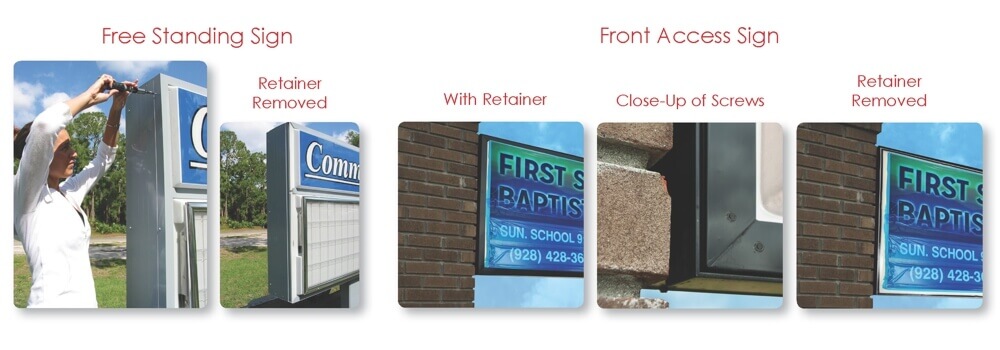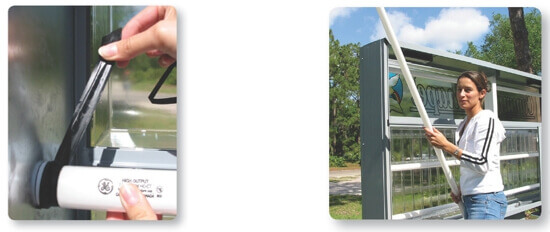Faces, Cabinets & Support Structures
Hardware Support
Find instructions on opening sign cabinets, replacing lamps, general cleaning and care, removing graffiti and more. If you are interested in purchasing new faces for your sign, please contact our Sales Department.
Operation
If the sign is too bright when internally illuminated and uses fluorescent lamps, use black electrical tape to wrap each lamp in a loose barber-pole fashion. Remember that this is only to reduce the lamp output, and too much tape will overly darken the sign. Do not use this method with internal LED lighting.
For instructions on reducing the brightness of your LED display, see the Software page.
Maintenance
![]() Sign Maintenance Manual
for printable instructions.
Sign Maintenance Manual
for printable instructions.
For Maintenance on Freestanding and Front Access Signs
-
Unscrew the aluminum retainer (molding) and pull it off.
For a free standing sign you only need to remove one side.
For front access signs you will need to remove the entire retainer (all four sides)
to access the message center and/or logo panel.

-
For free standing signs, slide out and remove the message center,
header and logo panel (if applicable).
For front access signs, pop the panel off from the front.
You will now have access to the fluorescent lamps and ballast.

- If this is the first time you have changed the lamps in your sign, you may need to remove electrical tape securing the lamps in the sockets. This was done for shipping purposes before the original delivery. There is no need to re-tape the new lamps.
-
Remove the lamps by firmly grasping the tube with both hands and pushing toward the end
which has the spring loaded socket; or "roll out" in the case of non spring-loaded sockets.

- Replace the burned out lamp with an equivalent high output lamp. The necessary information is found on one end of each lamp. If this is no longer legible, contact us.
- Replace both the face and the retainer along with any screws that may be in the face.
The internal illumination for the sign cabinet is driven by a ballast for fluorescent lamps or power supply for LED lamps.
- Disconnect power from the sign and open the cabinet.
- Remove the raceway around the ballast to expose the power connections.
- Disconnect the power wires.
- Remove the ballast from the raceway by removing the two 1/4 inch hex head screws at either end of the ballast.
- Replace the ballast.
- Close the sign and reconnect power.
- Disconnect power from the sign and open the cabinet.
- Remove the raceway around the power supply to expose the power connections.
- Disconnect the power wires from the Wago Terminal connector.
- On the DC side, the red wire is positive (+), the black wire is negative (-).
- On the AC side, the brown wire is hot/line and the blue wire is neutral.
- Remove the power supply from the raceway by removing the two 1/4 inch hex head screws at either end of the power supply.
- Replace the power supply.
- Close the sign and reconnect power.
Cleaning the Sign Cabinet
Upon the arrival of your new sign, we recommend you wax all painted surfaces of your sign (the cabinet, legs and any trim) with a clear automotive wax. Occasional re-application of a wax polish maintains the look of your sign while slowing down the aging and weathering process. Approved products to wax your sign are Johnson Paste Wax, Turtle Wax, or Meguiar's Glaze. To remove calcium or lime deposits, use a solution of 10 parts water to 1 part vinegar or a solution of 1 part water to 1 part baking soda.
Cleaning the Sign Face
The sign face is the translucent plastic portions of your sign, including the header area, logo area and vandal cover. Clean periodically with the following steps to prolong the life of these components:
- Rinse the face with lukewarm water.
- Using a soft cloth or sponge, gently wash the face with mild dish soap and lukewarm water. Do not scrub using brushes, squeegees, or other abrasive materials. For more difficult areas, the following cleaning products are approved for use on the sign face: Windex with Ammonia D, Top Job, VM and P grade Naptha, Freon TF, or a bleach solution (1 cup bleach to 1 gallon water).
- Dry with a soft cloth to prevent water spotting.
For best results, treat graffiti within the first 24 hours and use the appropriate solvent. For spray paint and other paints, mineral spirits should be used first. If necessary, stronger solvents like acetone, lacquer thinner or a paint reducer may be used. For dried egg and permanent marker on metal surfaces, 3M Bug & Tar, WD-40 or isopropyl alcohol can be used.
If possible, test your solvent in a non-conspicuous area before continuing. Start at the top of the graffiti and move downward with gentle rubbing motions using a soft, lint-free cloth. Do not use excess pressure, as this may negatively affect the sign coating. Continually move over the affected area and change the cloth frequently. Repeat until the graffiti is removed.
Cowling is the metal sheet spanning the sign's legs, giving the support structure a solid pedestal appearance. Cowling can be added or replaced using the following method. This procedure should only be followed when ambient temperature is above 60°F.
- Clean off any dust or fingerprints from both legs and the new cowling using the "Cleaning the Sign Cabinet" instructions above.
- Apply the provided double-sided tape to the legs. Do not overlap any existing old tape. Before you peel the backing off of the tape, do a dry fit of the cowling.
- Peel the backing off of the tape and lineup the cowling so that the edges are parallel with the legs. Make sure that the spacing on all sides is the same.
- Once the cowling is secure, apply pressure opposite the tape on both sides of the sign. Do not apply pressure to the center of the cowling.
Trim is the metal accent piece added to the top and bottom of a sign cabinet. Because the bottom trim is typically welded to the support structure, these instructions apply to the top trim piece only.
- Disconnect power from the sign and open the cabinet.
- Slide the faces out of the cabinet. Some faces on larger signs may be held in place by screws that will need to be removed.
- Remove the lamps from the cabinet.
- Remove the sheet metal screws along the top inside of the sign. This will release the cover and expose the electrical wires.
- Remove the screws that go through the top aluminum cabinet extrusion. To hold frame in place, remove top trim from the cabinet.
- To install the new trim, place trim on top of sign in the same location as original trim. Hold new trim in place securely and drill through the existing holes into the aluminum cabinet. Insert screws and tighten.
- Replace wire cover, bulbs and faces. Close the sign and restore power.
Vinyl letters and numbers can be added to the painted surfaces of your sign. How they are applied depends on whether the letters are for dry or wet application. If you are just replacing one or two letters, there should be no need to wet the vinyl; it can be applied dry. Before beginning, clean the area using the cleaning the sign cabinet instructions.
Applying Dry Vinyl
- Measure and mark where letters will go.
- The letters will come to you already taped, so just peel tape of the letter to be applied from backing.
- Lineup bottom of tape with your markings starting at bottom left corner.
- Carefully using a squeegee or your fingers, adhere vinyl to surface.
Applying Wet Vinyl
- Using a spray bottle add a few drops of dish soap to water. A wet sponge and a little soap can also be used.
- Wet letters, tape and all, place on the marks.
- Squeegee out water and let dry.
- When dry, remove tape.